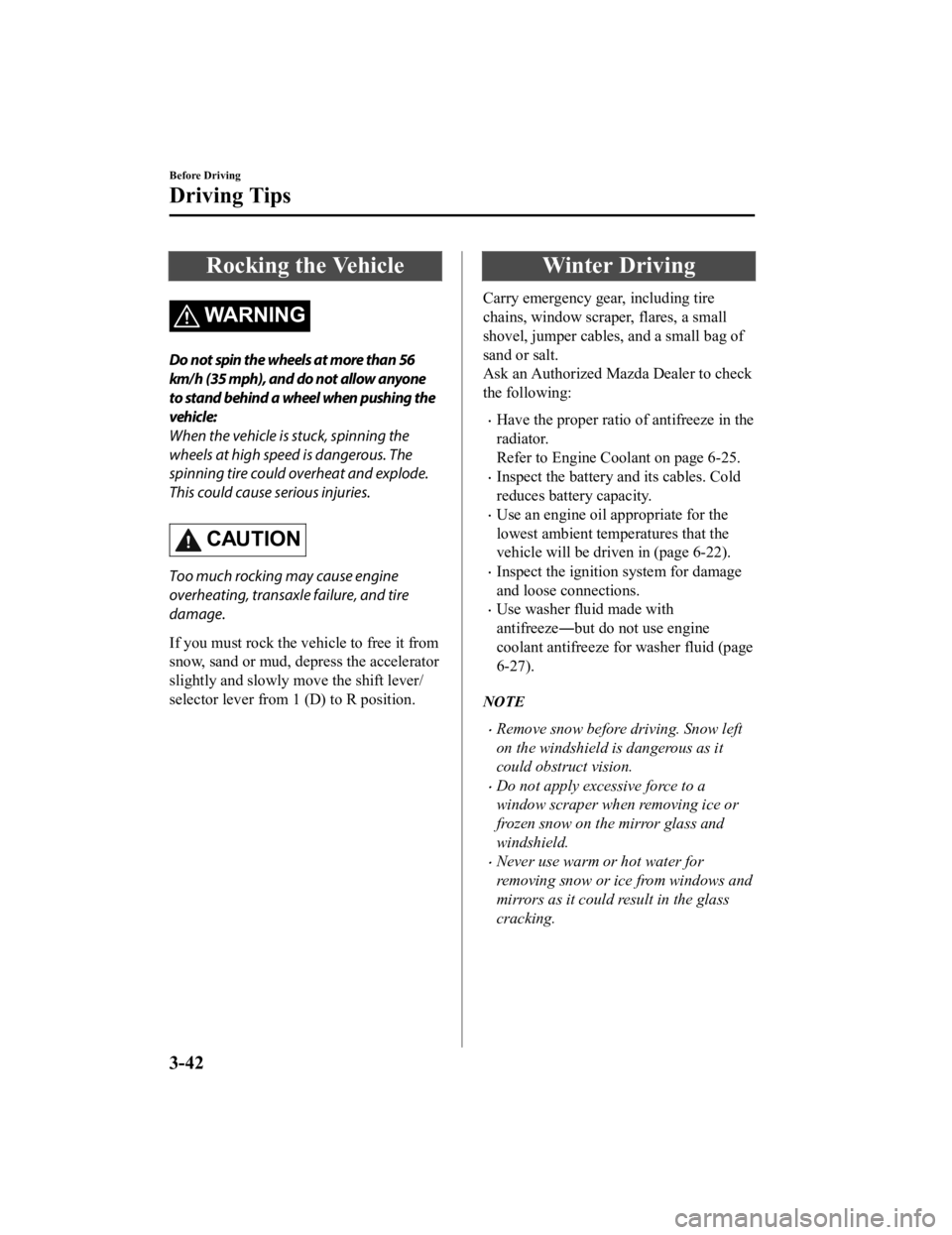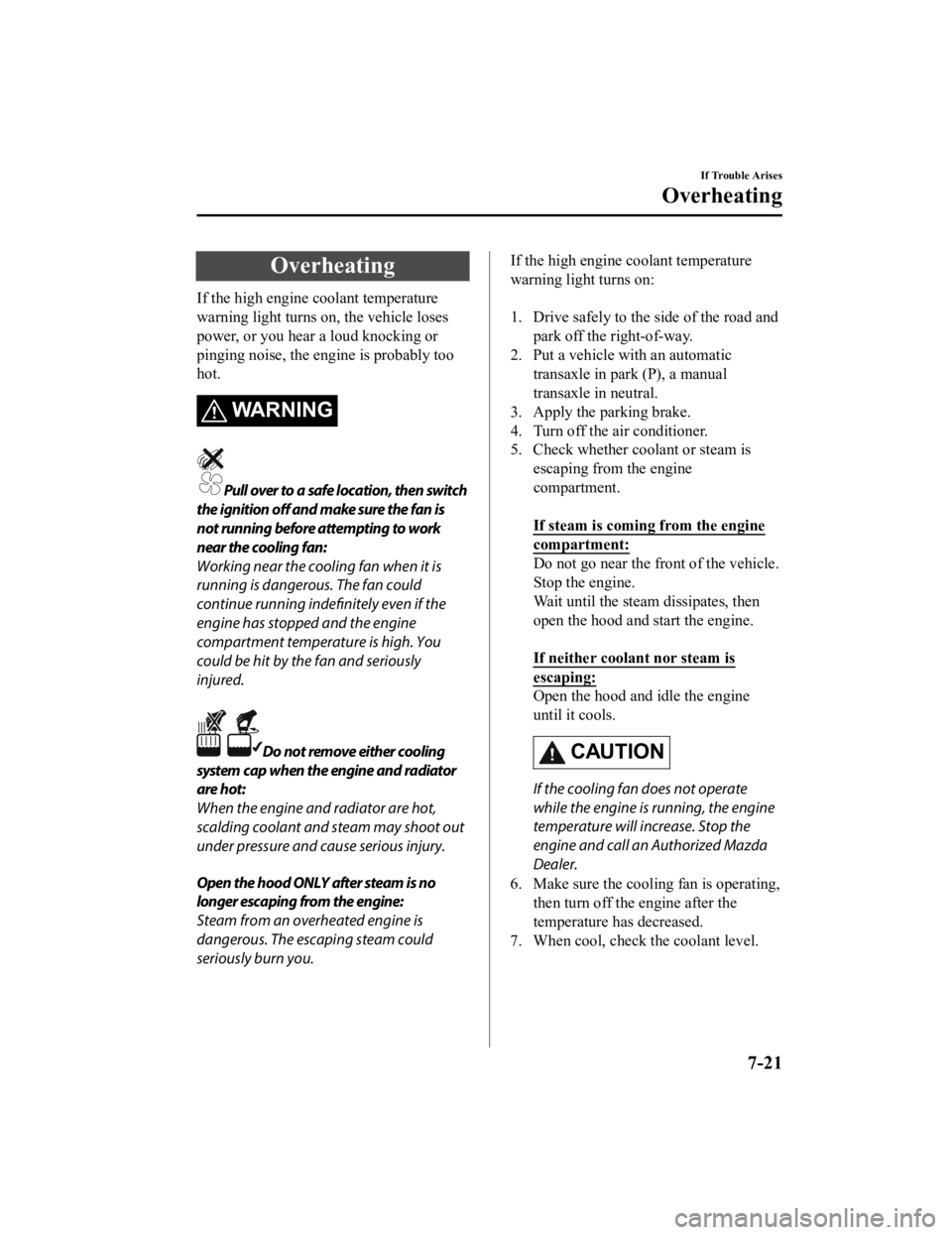engine overheat MAZDA MODEL CX-3 2021 Owners Manual
[x] Cancel search | Manufacturer: MAZDA, Model Year: 2021, Model line: MODEL CX-3, Model: MAZDA MODEL CX-3 2021Pages: 618, PDF Size: 64.58 MB
Page 124 of 618

Rocking the Vehicle
WA R N I N G
Do not spin the wheels at more than 56
km/h (35 mph), and do not allow anyone
to stand behind a wheel when pushing the
vehicle:
When the vehicle is stuck, spinning the
wheels at high speed is dangerous. The
spinning tire could overheat and explode.
This could cause serious injuries.
CAUTION
Too much rocking may cause engine
overheating, transaxle failure, and tire
damage.
If you must rock the vehicle to free it from
snow, sand or mud, depress the accelerator
slightly and slowly move the shift lever/
selector lever from 1 (D) to R position.
Winter Driving
Carry emergency gear, including tire
chains, window scraper, flares, a small
shovel, jumper cables, and a small bag of
sand or salt.
Ask an Authorized Mazda Dealer to check
the following:
Have the proper ratio of antifreeze in the
radiator.
Refer to Engine Coolant on page 6-25.
Inspect the battery and its cables. Cold
reduces battery capacity.
Use an engine oil appropriate for the
lowest ambient temperatures that the
vehicle will be driven in (page 6-22).
Inspect the ignition system for damage
and loose connections.
Use washer fluid made with
antifreeze ―but do not use engine
coolant antifreeze for washer fluid (page
6-27).
NOTE
Remove snow before driving. Snow left
on the windshield is dangerous as it
could obstruct vision.
Do not apply excessive force to a
window scraper when removing ice or
frozen snow on the mirror glass and
windshield.
Never use warm or hot water for
removing snow or ice from windows and
mirrors as it could result in the glass
cracking.
Before Driving
Driving Tips
3-42
CX-3_8JL1-EA-20G_Edition1_old 2020-5-22 15:31:00
Page 169 of 618

Driving Tips
WARNING
Do not let the vehicle move in a direction
opposite to the direction selected by the
selector lever:
Do not let the vehicle move backward with
the selector lever in a forward position, or
do not let the vehicle move forward with
the selector lever in the reverse position.
Otherwise, the engine may stop, causing
the loss of the power brake and power
steering functions, and make it difficult to
control the vehicle which could result in an
accident.
Passing
For extra power when passing another
vehicle or climbing steep grades, depress
the accelerator fully. The transaxle will
shift to a lower gear, depending on vehicle
speed.
NOTE
(Some models)
The accelerator pedal may initially feel
heavy as it is being depressed, then feel
lighter as it is depressed further. This
change in pedal force aids the engine
control system in determining how much
the accelerator pedal has been
depressed for performing kickdown, and
functions to control whether or not
kickdown should be performed.
While the selector lever is in the M
position and the TCS is turned off,
manual shift mode does not switch to
automatic shift mode even if the
accelerator pedal is completely
depressed. Operate the selector lever.
Climbing steep grades from a stop
To climb a steep grade from a stopped
position:
1. Depress the brake pedal.
2. Shift to D or M1, depending on the load weight and grade steepness.
3. Release the brake pedal while gradually accelerating.
Descending steep grades
When descending a steep grade, shift to
lower gears, depending on load weight and
grade steepness. Descend slowly, using the
brakes only occasionally to prevent them
from overheating.
When Driving
Automatic Transaxle
4-39
CX-3_8JL1-EA-20G_Edition1_old 2020-5-22 15:31:00
Page 185 of 618

Brake System
▼Foot Brake
This vehicle has power-assisted brakes
that adjust automatically through normal
use.
Should power-assist fail, you can stop by
applying greater force than normal to the
brake pedal. But the distance required to
stop will be greater than usual.
WARNING
Do not coast with the engine stalled or
turned
off,
find a safe place to stop:
Coasting with the engi ne stalled or turned
off is dangerous. Braking will require more
effort, and the brake's power-assist could
be depleted if you pump the brake. This will
cause longer stopping distances or even an
accident.
Shift to a lower gear when going down
steep hills:
Driving with your foot continuously on the
brake pedal or steadily applying the brakes
for long distances is dangerous. This causes
overheated brakes, resulting in longer
stopping distances or even total brake
failure. This could cause loss of vehicle
control and a serious accident. Avoid
continuous application of the brakes.
Dry off brakes that have become wet by
driving slowly, releasing the accelerator
pedal and lightly applying the brakes
several times until the brake performance
returns to normal:
Driving with wet brakes is dangerous.
Increased stopping distance or the vehicle
pulling to one side when braking could
result in a serious accident. Light braking
will indicate whether the brakes have been
affected.
CAUTION
Do not drive with your foot held on the
brake pedal. Doing so could result in the
following:
The brake parts will wear out more
quickly.
The brakes can overheat and adversely
affect brake performance.
Always depress the brake pedal with the
right foot. Applying the brakes with the
unaccustomed left foot could slow your
reaction time to an emergency situation
resulting in insufficient braking
operation.
Wear shoes appropriate for driving in
order to avoid your shoe contacting the
brake pedal when depressing the
accelerator pedal.
▼ Electric Parking Brake (EPB)
The EPB equipment applies the parking
brake using an electric motor. When the
When Driving
Brake
4-55
CX-3_8JL1-EA-20G_Edition1_old
2020-5-22 15:31:00
Page 292 of 618

5. After cooling begins, adjust the fancontrol dial and temperature control
dial as needed to maintain maximum
comfort.
CAUTION
If the air conditioner is used while driving
up long hills or in heavy traffic, monitor the
high engine coolant temperature warning
light to see if it is illuminated or flashing
(page 7-26).
The air conditioner may cause engine
overheating. If the warning light is
illuminated or flashing, turn the air
conditioner off (page 7-21).
NOTE
(Type A)
When maximum cooling is desired, set
the temperature control dial to the
extreme cold position and set the air
intake selector to the recirculated air
position, then turn the fan control dial
fully clockwise.
(Type B)
When maximum cooling is desired, set
the temperature control dial to the
extreme cold position and set the air
intake selector to the recirculated air
position, then set the fan control dial to
position 4.
If warmer air is desired at floor level,
set the mode selector dial at the
position and adjust the temperature
control dial to maintain maximum
comfort.
The air to the floor is warmer than air
to the face (except when the temperature
control dial is set at the extreme hot or
cold position).
▼ Ve n t i l a t i o n
1. Set the mode selector dial to the
position.
2. (Type A)
Set the air intake selector to the outside
air position.
(Type B)
Set the air intake selector to the
position.
3. Set the temperature control dial to the
desired position.
4. Set the fan control dial to the desired
speed.
▼Windshield Defrosting and
Defogging
1. Set the mode selector dial to the
position.
2. (Type B)
Set the air intake selector to the
position.
3. Set the temperature control dial to the desired position.
4. Set the fan control dial to the desired speed.
5. If dehumidified heating is desired, turn on the air conditioner.
Interior Features
Climate Control System
5-10
CX-3_8JL1-EA-20G_Edition1_old 2020-5-22 15:31:00
Page 495 of 618

7If Trouble Arises
Helpful information on what to do if a problem arises with the vehicle.
Parking in an Emergency................. 7-2 Parking in an Emergency..............7-2
Flat Tire.............................................. 7-3 Spare Tire and Tool Storage......... 7-3
Changing a Flat Tire..................... 7-8
Battery Runs Out............................ 7-17 Jump-Starting............................. 7-17
Emergency Starting.........................7-20 Starting a Flooded Engine.......... 7-20
Push-Starting.............................. 7-20
Overheating......................................7-21 Overheating................................ 7-21
Emergency Towing.......................... 7-23 Towing Description.................... 7-23
Tiedown Hooks*......................... 7-24
Warning/Indicator Lights and
Warning Sounds.............................. 7-26 If a Warning Light Turns On or
Flashes........................................ 7-26
Message Indicated on Display
*..........
.................................................... 7-40
Warning Sound is Activated....... 7-42
When Liftgate Cannot be
Opened..............................................7-47 When Liftgate Cannot be
Opened........................................7-47
Active Driving Display Does Not
Operate............................................. 7-48 If the Active Driving Display Does
Not Operate................................ 7-48
*Some models.7-1
CX-3_8JL1-EA-20G_Edition1_old 2020-5-22 15:31:00
Page 515 of 618

Overheating
If the high engine coolant temperature
warning light turns on, the vehicle loses
power, or you hear a loud knocking or
pinging noise, the engine is probably too
hot.
WARNING
Pull over to a safe location, then switch
the ignition off and make sure the fan is
not running before attempting to work
near the cooling fan:
Working near the cooling fan when it is
running is dangerous. The fan could
continue running indefinitely even if the
engine has stopped and the engine
compartment temperature is high. You
could be hit by the fan and seriously
injured.
Do not remove either cooling
system cap when the engine and radiator
are hot:
When the engine and radiator are hot,
scalding coolant and steam may shoot out
under pressure and cause serious injury.
Open the hood ONLY after steam is no
longer escaping from the engine:
Steam from an overheated engine is
dangerous. The escaping steam could
seriously burn you.
If the high engine coolant temperature
warning light turns on:
1. Drive safely to the side of the road and park off the right-of-way.
2. Put a vehicle with an automatic transaxle in park (P), a manual
transaxle in neutral.
3. Apply the parking brake.
4. Turn off the air conditioner.
5. Check whether coolant or steam is
escaping from the engine
compartment.
If steam is coming from the engine
compartment:
Do not go near the front of the vehicle.
Stop the engine.
Wait until the steam dissipates, then
open the hood and start the engine.
If neither coolant nor steam is
escaping:
Open the hood and idle the engine
until it cools.
CAUTION
If the cooling fan does not operate
while the engine is running, the engine
temperature will increase. Stop the
engine and call an Authorized Mazda
Dealer.
6. Make sure the cooling fan is operating, then turn off the engine after the
temperature has decreased.
7. When cool, check the coolant level.
If Trouble Arises
Overheating
7-21
CX-3_8JL1-EA-20G_Edition1_old 2020-5-22 15:31:00
Page 516 of 618

If it is low, look for coolant leaks from
the radiator and hoses.
If you find a leak or other damage, or if
coolant is still leaking:
Stop the engine and call an Authorized
Mazda Dealer.
Cooling system cap Coolant reservoir
Cooling fan
If you find no problems, the engine is
cool, and no leaks are obvious:
Carefully add coolant as required (page
6-25).
CAUTION
If the engine continues to overheat or
frequently overheats, have the cooling
system inspected. The engine could be
seriously damaged unless repairs are
made. Consult an Authorized Mazda
Dealer.
If Trouble Arises
Overheating
7-22
CX-3_8JL1-EA-20G_Edition1_old 2020-5-22 15:31:00
Page 522 of 618

SignalWarning
Charging System Warn‐
ing Light If the warning light illuminates while driving, it indicates a malfunction of the alter
‐
nator or of the charging system.
Drive to the side of the ro ad and park off the right-of -way. Consult an Authorized
Mazda Dealer.CAUTION
Do not continue driving when the charging system warning light is illuminated be‐
cause the engine could stop unexpectedly.
Engine Oil Warning Light This warning light indicates low engine oil pressure.
CAUTION
Do not run the engine if the oil pressure is
low. Otherwise, it could result in extensive
engine damage.
If the light illuminates or the warning indication is displayed while driving:
1. Drive to the side of the road and pa rk off the right-of-way on level ground.
2. Turn off the engine and wait 5 minutes fo r the oil to drain back into the oil pan.
3. Inspect the engine oil level (page 6-24). If it's low, add the appropriate amount of
engine oil while being careful not to overfill.
CAUTION
Do not run the engine if the oil level is low. Otherwise, it could result in extensive
engine damage.
4. Start the engine and check the warning light.
If the light remains illuminated even though th e oil level is normal or after adding oil,
stop the engine immediately and have your vehicle towed to an Authorized Mazda
Dealer.
(Red)
High Engine Coolant
Temperature Warning Light The light flashes when the engine coolant temperature is extremely high, and illumi
‐
nates when the engine coolant temperature increases further.
Handling Procedure
Flashing light
Drive slowly to reduce engine load until you can find a safe place to stop the vehicle
and wait for the engine to cool down.
Illuminated light
This indicates the possibility of overheati ng. Park the vehicle in a safe place immedi ‐
ately and stop the engine.
Refer to Overheating on page 7-21.
CAUTION
Do not drive the vehicle with the high engine coolant temperature warning light illumi‐
nated. Otherwise, it could resu lt in damage to the engine.
If Trouble Arises
Warning/Indicator Lights and Warning Sounds
7-28
CX-3_8JL1-EA-20G_Edition1_old 2020-5-22 15:31:00
Page 614 of 618

Index
Traffic Sign Recognition System
(TSR)........................................... 4-93
i-ACTIV AWD Operation.................4-73
J
Jack...................................................... 7-5
Jump-Starting.................................... 7-17
K
Keyless Entry System......................... 3-4
Keys.....................................................3-2
Key suspend function.................... 3-8
Transmitter..................................... 3-5
Key left-in-luggage compartment
warning beep (With the advanced keyless
function)............................................ 7-44
Key left-in-vehicle warning beep (With
the advanced keyless function)......... 7-44
Key removed from vehicle warning
beep................................................... 7-43
Key Suspend Function........................ 3-8
L
Label Information............................... 9-2
Lane Departure Warning sound........ 7-45
Lane Departure Warning System
(LDWS)............................................. 4-82 LDWS switch.............................. 4-84
Lane-Change Signals........................ 4-47
Leaving Home Light......................... 4-45
Liftgate.............................................. 3-19 Luggage compartmen t................. 3-21
When Liftgate Cannot be
Opened......................................... 7-47
Lighting Control................................4-40
Lights-on reminder............................7-42
Light Bulbs Replacement................................ 6-40
Specifications.................................9-6
Lubricant Quality................................ 9-4
Luggage Compartment Light.......... 5-142
M
Maintenance Information.................................... 6-2
Scheduled.......................................6-4
Maintenance Monitor........................ 6-14
Manual Transaxle Operation............. 4-27
Map Lights...................................... 5-142
Mazda Radar Cruise Control with Stop &
Go function (MRCC with Stop & Go
function).......................................... 4-104 Close proximity warning........... 4-106
Cruise control func tion.............. 4-113
Display indication......................4-106
Setting the system..................... 4-107
Stop hold control....................... 4-112
Mazda Radar Cruise Control with Stop &
Go function (MRCC with Stop & Go
function) System Warnings............... 7-45
Message Indicated on Display.......... 7-40
Meters and Gauges............................4-11
Mirrors Outside mirrors............................ 3-28
Rearview mirror.......................... 3-29
Mirror Defogger.......... ...................... 4-53
Moonroof...........................................3-33
O
Odometer and Trip Meter................. 4-12
Outside Mirrors................................. 3-28
Outside Temperature Display............4-15
Overhead Console..... ...................... 5-147
Overhead Lights......... ..................... 5-142
Overheating....................................... 7-21
Overloading....................................... 3-45
Owner Maintenance Closing the Hood.........................6-19
Engine Compartment
Overview..................................... 6-21
10-6
CX-3_8JL1-EA-20G_Edition1_old 2020-5-22 15:31:00
Page 616 of 618

Index
Smart Brake Support (SBS) indicator
light (red)................................... 4-125
Stopping the Smart Brake Support
(SBS) system operation............. 4-125
Smart City Brake Support
(SCBS)............................................ 4-120 Collision warning.... .................. 4-122
Smart City Brake Support (SCBS)
Indicator Light (Red).................4-122
Stopping the Smart City Brake
Support (SCBS) System
Operation................................... 4-122
Spare Tire............................................ 7-6
Specifications...................................... 9-4
Speedometer...................................... 4-12
Speed Unit Selector.......................... 4-12
SRS Air Bags
Front passenger occupant
classification system.................... 2-66
How the SRS air bags work........ 2-59
Limitations to SRS air bag.......... 2-64
Monitoring................................... 2-70
SRS air bag deployment
criteria.......................................... 2-63
Supplemental restraint system
components.................................. 2-57
Starting the Engine..............................4-5
Steering Wheel
Heated steering wheel................. 2-20
Horn............................................. 4-53
Storage Compartments .................... 5-147
Center console........................... 5-148
Glove compartment................... 5-148
Overhead console...................... 5-147
Rear coat hooks........ ................. 5-150
Sunshade............................................3-35
Sunvisors......................................... 5-142
T
Tachometer........................................ 4-13
Theft-Deterrent System..................... 3-38
Tiedown Hook.............. .............................. 7-24
Tires................................................... 6-36
Flat Tire......................................... 7-3
Replacing a Tire.......................... 6-38
Replacing a Wheel...................... 6-39
Snow tires.................................... 3-43
Specifications.................................9-7
Temporary Spare Tire..................6-38
Tire chains................................... 3-43
Tire Inflation Pressure................. 6-36
Tire Rotation................................6-37
Uniform tire quality grading system
(UTQGS)..................................... 8-23
Tire inflation pressure warning
beep................................................... 7-44
Tire Information................................ 8-25
Tire Pressure Monitoring System.... 4-140
To w i n g
Recreational towing.....................3-47
Trailer Towing............................. 3-47
Towing Description........................... 7-23
Traction Control System (TCS)........ 4-66 TCS OFF Indicator Light............ 4-67
TCS OFF Switch......................... 4-67
TCS/DSC Indicator Light............4-66
Traffic Sign Recognition System
(TSR)................................................. 4-93
Transmitter.......................................... 3-5
Trip Computer................................... 4-16
Trip Meter......................................... 4-12
Trouble Battery runs out........................... 7-17
Emergency Starting..................... 7-20
Emergency Towing......................7-23
Flat Tire......................................... 7-3
Overheating................................. 7-21
Parking in an Emergency.............. 7-2
When Liftgate Cannot be
Opened......................................... 7-47
10-8
CX-3_8JL1-EA-20G_Edition1_old 2020-5-22 15:31:00